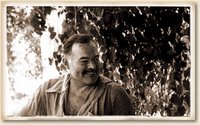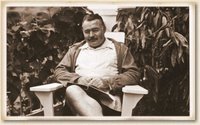 Absinthe - A Bohemian Rhapsody
Absinthe - A Bohemian RhapsodyAnthony Dobranski - writer, sipster extraordinaire and half of one of our favorite couples (aka: Tony-and-Jackie) bestowed a rare pleasure upon Jason (the other half of my couple) and me on Bastille Day...
I'm enraptured with "la vie boheme" and literary movement in 1920's Paris. Smoke-filled rooms alive with witty banter, steamy opium-and-absinthe laden brothels, the languid stares of art-deco seductresses who'd seen a little too much of post-war reality... All these romanticized, fanciful illusions danced in my head as Tony, Jackie, Jason and I prepared to sample this most notorious of illicit libations!
I wasn't sure what to expect. Would we hallucinate? How powerful was this stuff, anyway? I was all tingly in anticipation...
Personally, I didn't experience any physical reactions other than the thrill of tasting it (finally!) for myself. It's licorice flavor is simply delightful, the experience as "heady" as any fine (and strong) spirit, and adding Absinthe to my list of 1001 things to try before I die is one more accomplishment to cross off my list! (not that I wouldn't do it again!!)
Tony knows more about it than I do, so I asked him to share a little info. Enjoy...
 The Liquid Muse wanted to join the many recent celebrations of New Orleans -- "Laissez le bons temps roulez" is a fine motto. Alas, for mixologists New Orleans is difficult. The hometown cocktail is as sweet as childrens' cereal, sold in paper cups, and worst of all is called ... a hurricane.
The Liquid Muse wanted to join the many recent celebrations of New Orleans -- "Laissez le bons temps roulez" is a fine motto. Alas, for mixologists New Orleans is difficult. The hometown cocktail is as sweet as childrens' cereal, sold in paper cups, and worst of all is called ... a hurricane.Instead we're honoring New Orleans native son Ted Breaux, a chemist who in his spare time figured out how to make Nouvelle-Orleans -- perhaps the world's best absinthe. Absinthe? Isn't that the evil toxic drink that destroyed a generation of artists and poets in 19th century Paris?
Well, yes. Actually, as we learned in a great article in Wired magazine about Mr Breaux, absinthe isn't really toxic, at least not if it's made correctly. But it is strong -- 140 proof and wildly aromatic. Traditionally it's served diluted with ice-cold water and sweetened with a sugar cube. Our photos demonstrate a traditional method, using antique-style crystal absinthe glasses with matching funnels.

Absinthe is naturally wine-bottle green, but when diluted with water it turns the color of key-lime pie. By placing a sugar cube in the funnel, the water dissolves it as it trickles through. A perfect aperitif for Bastille Day or any hot summer night!
Where to get this fine drink? NOT in European duty-free shops, alas. Most of the "absinthe" sold there is closer to mouthwash than something you want to swallow. The good stuff is available, but since it's illegal in the US we're not going to tell you where. That's why they invented search engines, honey.












